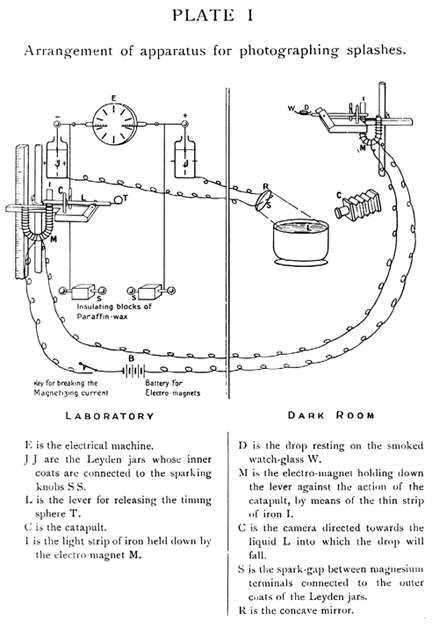When people think of high-speed photography, the name that most often comes to mind is Harold “Doc” Edgerton. And rightly so, as he contributed so much to the discipline.
However, in 1876, A. M. Worthington wrote a paper entitled “A Second Paper on The Forms Assumed by Drops of Liquids falling vertically on a Horizontal Plate”; in 1908, he published a book, “A Study of Splashes,” which contained 300 photographs and drawings to supplement his narrative. He captured those images using high-speed photography. Doc was but five years old at the time.
The techniques that Worthington used were wonderfully simple:
He created a short burst of light with an open-air spark gap powered by Leyden jars (it was Doc that put inert gases and modern capacitors to work). The flash was triggered by an iron ball falling onto a pair of contacts. He timed the flash by having two identical mechanisms: one for dropping the iron ball, and one for dropping the droplet of water. By adjusting the heights of the two mechanisms, he could quite accurately determine the timing.
The dropping mechanism consisted of a spoon mounted horizontally on a pivot. It was spring-loaded and held horizontal by an electromagnet. When the electromagnet was de-energized, the spoon snapped downward, accelerating rather faster than gravity, and whatever was held in the bowl of the spoon had no place to go but down. The two electromagnets were driven by the same circuit, so they de-energized simultaneously.
He could create a drop of a predetermined size by adding as much water to the spoon as he wanted. The only tricky part was that the surface tension of the water caused the droplet to stick to the spoon. This was solved by coating the spoon’s inner surface with lamp-black – he simply held it over a candle for a bit. The powdered carbon surface supported the water without adhering to it. You can see the remnants of the soot in some of his photos.
As I consider the amount of compute power I use in my studio, I am humbled by what a clever man did a hundred and twenty years ago.

(diagram from “A Study of Splashes”, by A. M. Worthington)

What a fascinating story and illustration. I’m just astounded that someone was actually able to do water drop photography in 1876 and even wrote a book on it! Here we are with our modern digital cameras with high speed flash, photogates and microcontrollers, and I thought waterdrop photography was a somewhat recent endeavor for photographers. It’s also amazing to me that, while he was using a Leyden jar (!), his use of an electric circuit with an electromagnet to release the water drop employs the same basic physical principle as what we do today with a solenoid valve and its coil, only with the added convenience of more modern electronics for better control. Thanks for finding and sharing this.